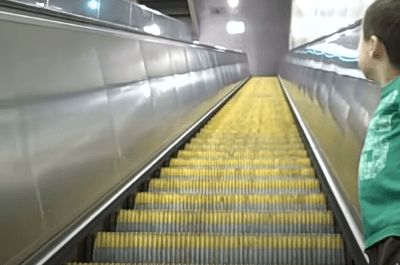lifts and escalators are commonplace in the commercial building and used for vertical transport from floor to floor.
If the number of floors is more than 4, then the practice of accommodating lifts and other forms of vertical transportation other the stairs is common in practice nowadays.
So, here I am going to show you how lifts and escalators are differing from each other even both are the mode of transport to ascend and descend from one floor to another.
Table of Contents
Difference between lifts and escalators
1) Lifts or Elevators

Elevators are used in buildings having more than four stories. They are used for vertical transportation of passengers of freight.
They can be either electrical traction elevators or hydraulic elevators. Electrical traction elevators are used in exclusively tall buildings whereas hydraulic traction elevators are generally used for low rise freight service which rises up-to 6 Storey.
Hydraulic elevators may also be used for low rise passenger service.
a) Component of Lift
The different components of an electrical traction elevator are the car or cab, hoist wire ropes, driving machine, control equipment, counterweight, hoistway rail, penthouse, and pit. The car is a cage of light metal supported in a listened to the counterweights.
b) Working of Lift
The path of both the counterweight and the car is controlled by a separate set of T-shaped guide rails.
The control and the operating machinery may be located in the pent-house located above the shaft or in a basement. Safety springs or buffers are placed in the pit, to bring a car or counter weight to a safe stop.
Elevators, serving more than three floors, should be provided with means for venting smoke and hot gases from the hoistways to the outer air in case of fire.
Vents may be located in the enclosures just below the uppermost floors, with direct openings to the outside or with non combustible duct connection to the outside. Vent area should be at least 3.5 % of the hoistway cross-sectional area.
2) Escalators

Escalators are powered stairs. They are used when it is necessary to move a large number of people from floor to floor. These stairs have a continuous operation without the need for operators.
a) Component of Escalators
They have a large capacity with low power consumption which is in the form of an inclined moving way spanning between two floors. The components escalator consists of a steel trussed framework, handrails, and an endless belt with steps.
b) Working of Escalators
At the upper end of escalators, there is a pair of motor-driven sprockets wheel.
Two precision-made roller chain travel over the sprockets pulling the endless belt of steps around the steps which move on an accurately made set of tracks attached to the trusses with each step supported on four resilient rollers.
Escalators are reversible in direction. They generally operated at a speed of 30 or 40 m/min. the slope of stairs is standardized at 30°.
For a given speed of travel width of step determines the capacity of powered stairs Escalators should be installed where traffic is heaviest and convenient for passengers.
In the design of the new building, adequate space should be allotted for powered stairs Structural framing should be made adequately to support them.
Escalators are generally installed in a pair. One of them is used for carrying up going and fic moving down.
The arrangement for escalators in each story can be either parallel or Criss-cross. Criss cross arrangement is more compact as it reduces the walking distance between floors at various floors to a minimum.
Conclusion
Among both of the mean of transportation from one floor to another floor, Escalators is safe as there is no chance of trapping on way when electricity cuts. But it may also be dangerous as Escalators is open which does not have wall protection like lift.
I Hope friends, you liked my written article on “Difference between Lift and Escalators” and remains helpful.
Read Also,
How to Calculate number of bricks, and quantity of cement,sand in wall
Different types of bond in bricks
Did you like it? Please Share it !!!